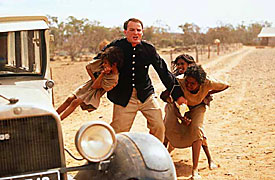 |
|
Photo courtesy of Miramax Films
|
Half-Aboriginal and half-white children are taken from their families in Australia in 1931. "Rabbit-Proof Fence," playing in theaters, is based on a true story.
|
|
By Mark Betancourt
Arizona Daily Wildcat
Thursday January 16, 2003
The best way to get an idea of the film "Rabbit-Proof Fence" would be to start at the movie's end. Two elderly aboriginal women take an afternoon stroll through a desert on deliberately realistic-looking home video, talking quietly in their native tongue. As the music swells, their names appear in simple white lettering beneath their images.
We thereby discover that the movie we have just watched is a true story, and as the credits roll we ponder the weight of it and perhaps cry. At least, that's the theory.
"Rabbit-Proof Fence" is set in western Australia in 1931, a time and place still deeply affected by the Aborigines Act of 1910, which legalized the removal of part-white aboriginal children from their families to be placed in western educational institutions.
At least, that's what it says in the opening titles. The film tells the true story of three girls who escape from one of those institutions after being taken from their mother and then walk the 1500 miles home by following a continental fence line designed to keep the rabbits out of west Australia.
This sounds like a great movie ÷ social commentary, beautiful scenery, and a long journey. For a lot of Australian films, like Nicolas Roeg's "Walkabout," for example, that journey is about people coming face-to-face with nature only to walk deeper into themselves.
In "Rabbit-Proof Fence" the kids are really just walking home.
Well, there's some social commentary. Or at least there appears to be. Kenneth Branagh plays Mr. Neville, the government official in charge of directing the transplant of aboriginal children, and he thinks he's doing the aborigines a service by systematically breeding the black out of them.
Okay, so a powerful white guy with good intentions has the wrong idea. That's pretty much the history of the world, nothing new there.
The rest of the film focuses on all the boringly clever ideas the girls have for evading their domesticated aboriginal tracker, like walking in a river instead of on the dirt. You know, so as not to leave their tracks.
That's pretty much the movie. In the end, we see the real life girls grown old, and their names appear on the screen. They say something about how they're never going back to that institution and the film ends.
There may be several explanations for why this film smacks of Tom Hanks on the trail of the History Channel's unsung war heroes. Perhaps chief among them is that the film's director is best known for making the films "Patriot Games" and "Clear and Present Danger," among others. That speaks for itself.
But really, here is an opportunity to show children fighting nature and an unfair government in a beautiful and dramatic setting. You'd think it'd be a piece of cake to actually work something out, tell some kind of truth about whatever it is that's true about the situation.
But all this film can come up with is a few self-consciously-placed pretty shots of sunsets and a protective hawk-spirit motif. Not too impressive.
This movie just goes to show that good films aren't just good stories, they're good stories told well. It has its moments, but all "Rabbit-Proof Fence" really amounts to in the end is the filmmakers asking "See, isn't it amazing that those kids did that?"
Yeah, it's amazing. Thanks.

